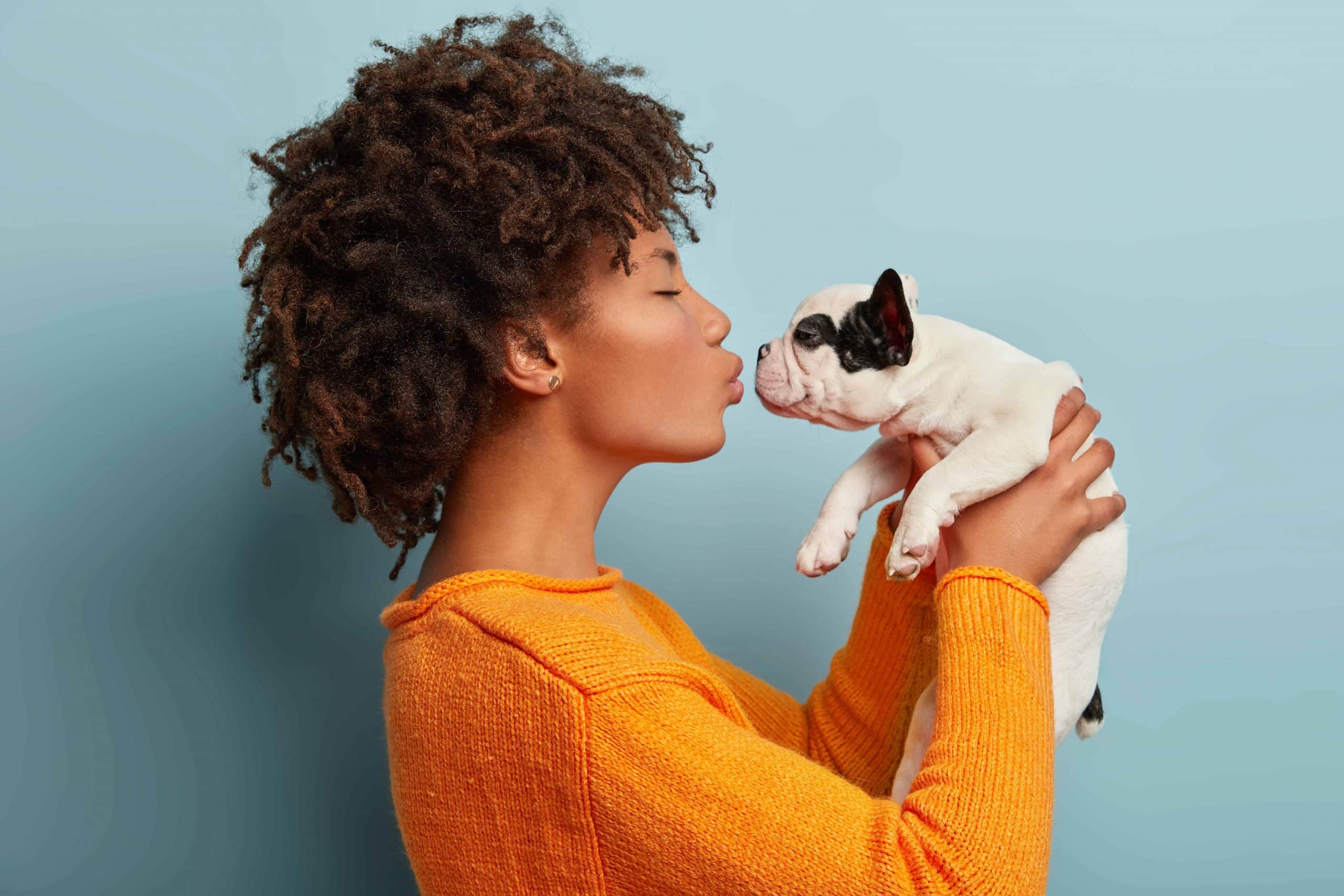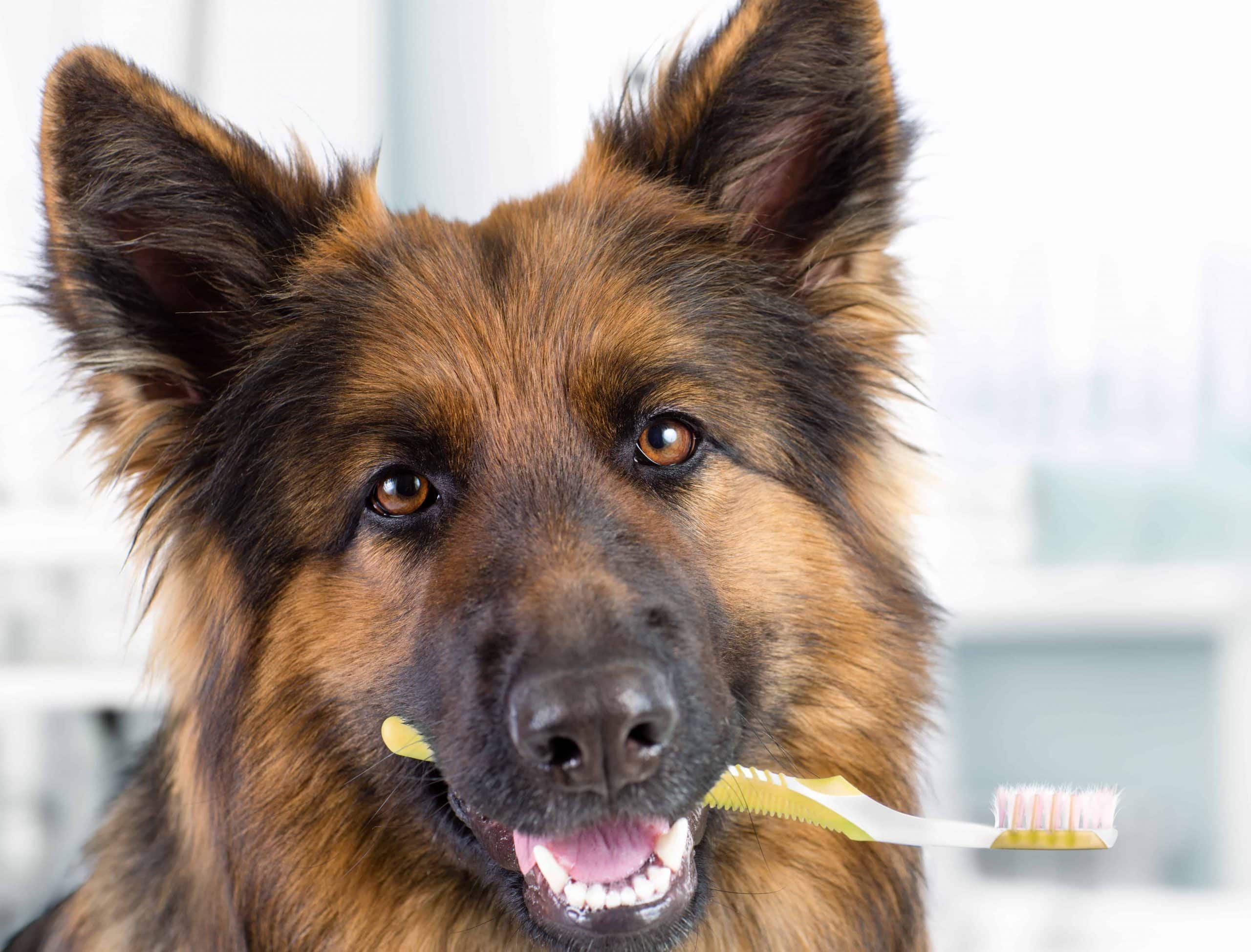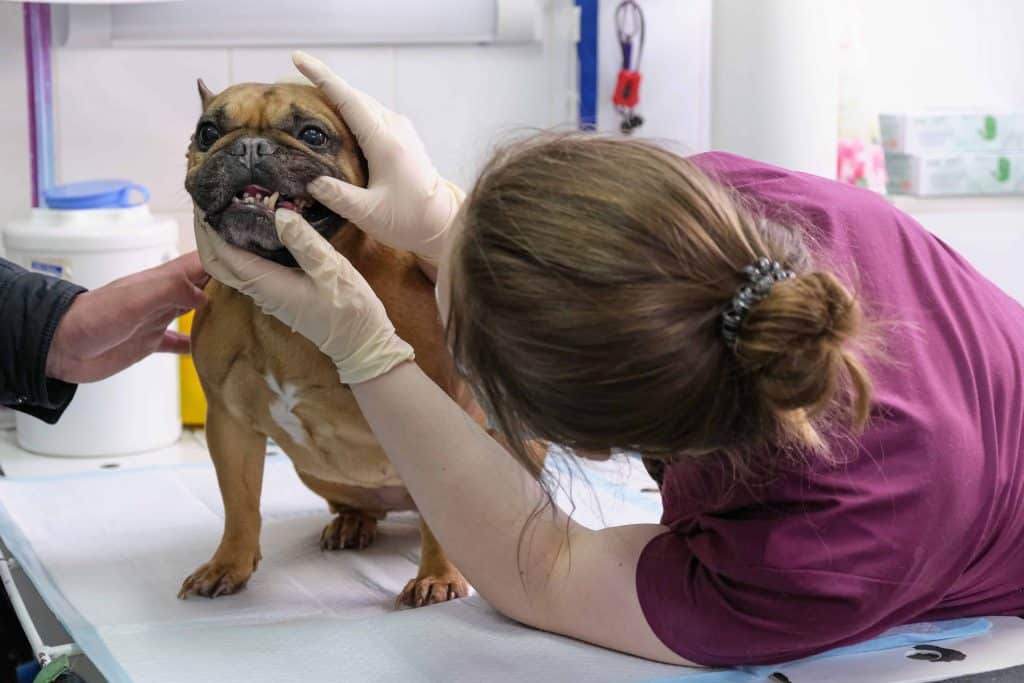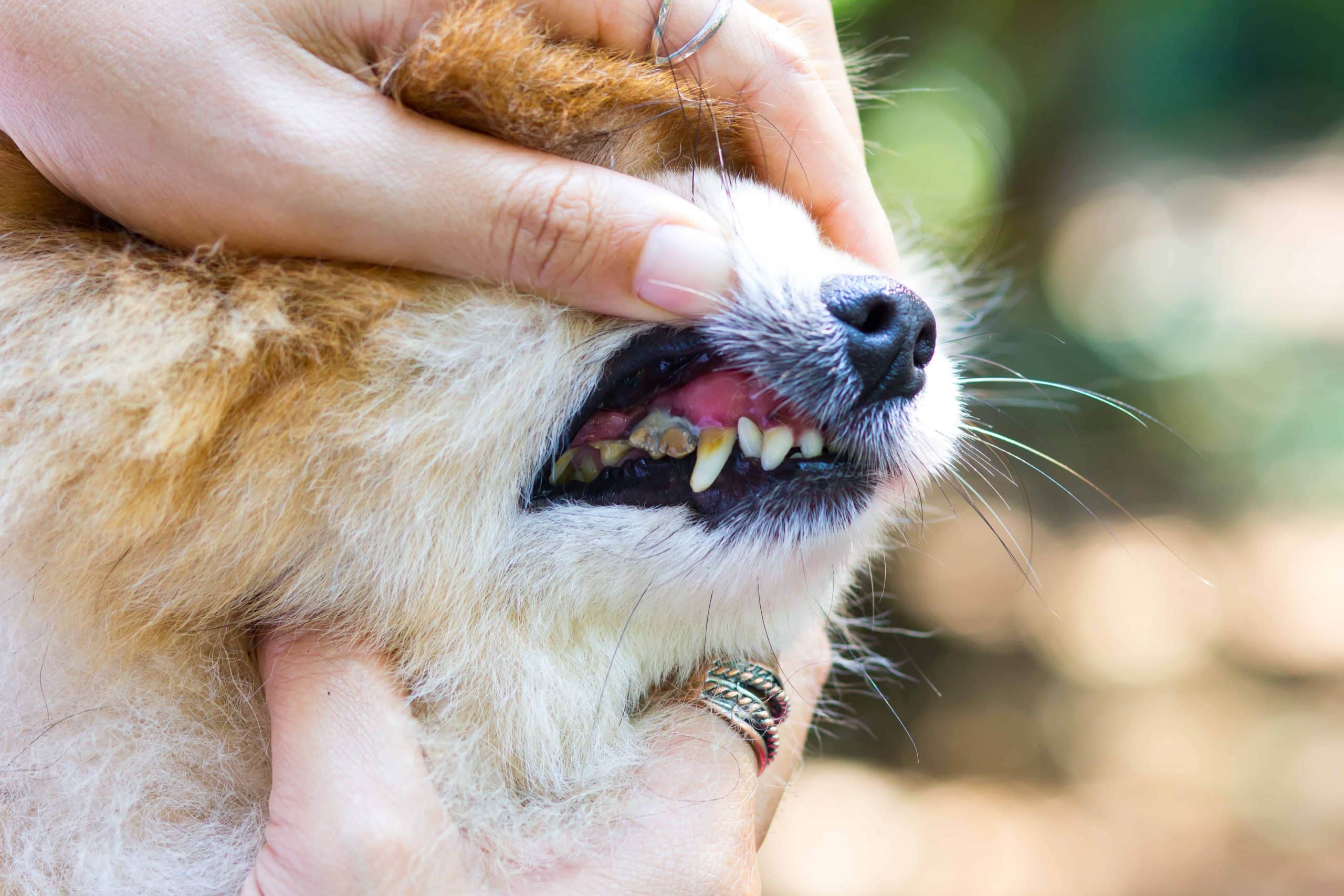If you catch yourself wrinkling your nose when Pup breathes near your face, canine gum disease could be the culprit.
Bad breath is one sign of periodontal disease in dogs – gum inflammation that occurs when plaque and tartar accumulate on the teeth.
This condition is widespread among dogs, impacting nearly 90 per cent of the population.
Thankfully a full recovery is likely, but only if the condition is treated early.
Unfortunately, untreated mild cases eventually progress to advanced periodontitis, a severe form of the disease. At this point, damage is irreversible and surgery is often required to remove infected teeth and tissue.
Here’s the worst part:
Severe gum disease can seriously harm your pup’s mouth, and even their entire body!
Many people are surprised to learn that oral bacteria can actually enter the blood and wreak havoc elsewhere (such as inflaming the heart).
This is why it’s so crucial to know how to treat periodontal disease in dogs at the very first signs – and even better, prevent it from occurring in the first place.
We’ll talk about treatment and prevention soon, but first, let’s look at the four stages of gum disease in dogs.
Canine periodontal disease stages (there are four)
Periodontal disease occurs when the tissue surrounding the tooth becomes inflamed from bad bacteria in plaque and tartar. At first, this inflammation is mild and easily treatable. But be warned, untreated inflammation will progress to severe infection that may damage the teeth, gums, jaw bone and other parts of the body.
Let’s look at each stage and the associated symptoms of periodontal disease in dogs.
Please note: your pooch doesn’t need to show all the signs to be diagnosed with gum disease.
First stage (gingivitis):
Canine gingivitis is mild gum inflammation that’s fairly easy to treat, and completely reversible if detected early.
Common signs of canine gingivitis:
- Swollen or puffy gums
- Slight redness of gums
- Visible tartar on teeth
- Bad breath (halitosis)
- Gums bleed when teeth are brushed
- Tenderness around the mouth
- Drooling
- Receding gums
- Eating is difficult
Second stage (early periodontitis):
The condition is starting to get a little more serious. This stage is characterised by some damage to the supportive structures of teeth – bone and ligaments. Many of the symptoms are the same as gingivitis but more noticeable, as inflammation is higher. You may notice loose teeth and weight loss too.
Third stage (moderate periodontitis):
The situation is worsening as the supportive structures now show up to 50 per cent of loss. You won’t be able to see much difference between early and mild periodontitis, but more bone damage will be visible in X-rays during the third stage.
Fourth stage (advanced periodontitis):
There’s now damage to more than 50 per cent of bone and ligament. You definitely won’t miss the tartar, as it’s more obvious.
Other symptoms include:
- Missing teeth
- Loose teeth
- Damaged teeth
- Pus from gums
- Tooth roots are visible
- Retracted gums
You may notice some odd changes in your furry pal’s behaviour, as the symptoms get worse:
- Aggressiveness
- Irritability
- Withdrawing from interactions
- Smacking gums together
- Loss of interest in playing with toys
- Resisting when having teeth brushed
- Uncomfortable when you touch teeth or lips
The earlier you seek medical intervention the better, as untreated canine periodontal disease can have devastating health impacts:
- Loss of teeth
- Chronic pain
- Fractured jaw
- Tooth infections
- Oronasal fistulas (holes between the mouth and nose)
- Cancer of the mouth
- Eye problems
- Damage to the heart and other organs!
How to treat periodontal disease in dogs
The first step is to take your pooch to the vet, if you notice any symptoms of gum inflammation or infection. Even if you think you may be overreacting over mild symptoms, it’s better to err on the side of caution rather than have regrets later.
Your vet will conduct an oral examination, which may include dental x-rays and instruments that measure bone loss.
Treatment depends on the stage of gum disease at hand.
Gingivitis is the easiest to treat with professional dental cleaning, followed by an application for fluoride that helps to keep bacteria away.
Early and moderate periodontitis requires a slightly more aggressive approach: deep scaling or scraping to banish plaque and tartar that has accumulated over time.
Teeth are then polished until they’re smooth, which makes it harder for bacteria to attach in the future. This entire process must be completed with general anaesthetic, and your pup should feel ok the next day. He or she will be prescribed antibiotics, painkillers and anti-inflammatory medication to ease discomfort and prevent infection.
Please note: you may need to pay more than you bargained for, because general anaesthetic drives up the fee!
What about treating advanced periodontitis?
Surgery is usually required to treat or remove infected teeth, bone and tissue. As you can imagine, this can cost thousands of dollars. Following the procedure, it will take around a week until your dog’s mouth no longer feels sensitive – but antibiotics, painkillers and anti-inflammatory meds will help take the edge off.
Is gum disease in dogs contagious to humans?
There seems to be mixed opinions! Some sources say no, humans cannot catch periodontal disease from their four-legged companion.
However, other experts aren’t convinced that oral bacteria doesn’t jump species.
In fact, one Japanese study found that humans and dogs can actually exchange harmful germs that cause tooth decay and gum disease. Porphyromonas gulae (p. gulae) is a pathogen associated with periodontal disease in dogs, and it was found in humans who had high-contact relationships with older dogs in particular.
From Wall Street Journal:
“P. gulae, rarely detected in humans, was found in 13 owners and their dogs, including two with low-contact relationships. This finding suggests bacteria can be transmitted from dogs to humans even with low contact, researchers said”.
We already know that cavities are contagious from human to human, so it’s not beyond the realm of possibility that oral bacteria can spread from man’s best friend too.
It looks like no more sloppy kisses from pup, just to be cautious!

What causes periodontal disease in dogs?
Poor oral hygiene is the main factor.
Plaque is a sticky film of harmful bacteria that forms every 24 hours, even in clean mouths. This plaque builds up and becomes hardened tartar (also known as calculus) when teeth aren’t brushed every day. Tartar and plaque first cause gum inflammation on the surface, before infection travels deep into the teeth and gums.
Genetics come into play too!
Any dog can get gum disease, no matter their breed. However, risk is higher for small breeds, or dogs with a shortened snout. Examples include Pugs, Yorkies, Boxers, Chihuahuas and Collies. This is largely because food is more easily trapped in smaller teeth, but also because small dogs don’t have as much bone to securely hold each tooth in place.
Dogs with a misaligned bite or under-developed jaw are also more likely to develop canine periodontal disease.
Prevention is always best
Not only will regular brushing treat mild inflammation and stop it from progressing; it will also prevent periodontal disease from occurring in the first place – which is what we should all be aiming for!
Just make sure you only brush Busta’s teeth with a toothpaste that’s made for dogs (never use human brands – fluoride is toxic to dogs).
The particulars of this routine is different for every dog, based on their breed and temperament, so you should seek advice from your vet – who may even recommend a special diet that helps to keep tartar at bay.
Finally, get into the habit of regularly checking your dog’s mouth for any abnormalities like swollen gums or wobbly teeth. At the first sign of trouble, book an appointment with your vet.

Potiki Dog Periodontal Insurance
As previously discussed, it can be expensive to treat gum disease. You may even find yourself out of pocket thousands of dollars, if tooth extraction is required.
Pawrents with reliable pet insurance don’t have to worry about having the funds to pay for vet fees. Their policy covers most of the costs (as long as it’s not a pre-existing condition).
Potiki’s affordable pet insurance gives you that peace of mind, but we go one step further…
We also send you free Potiki Perks to help prevent your best pal from getting sick in the first place.
All customers get access to Potiki Perks#. Potiki Perks# comes with the free Potiki Perks app offering exclusive offers, 2-for-1 deals, and up to 20% off in categories like dining, activities, shopping, travel, and more. You will also have access to myPetPass™** which unlocks extra support and savings on everyday pet essentials such as online vet care, discounted pet prescription medication and savings on premium pet food.
This is on top of reliable pet cover that pays for 80 per cent of your eligible vet bills for unexpected illness and injury.
- Get a quick Potiki quote to find out what your premium will cost for one year.
- Submit payment if you’re satisfied with that amount (email us on [email protected] with any questions).
- Log into your personal portal to select items for your Potiki Perks package, which will be swiftly delivered to you.
- Lodge a claim if you need help paying vet bills for unexpected sickness or injury.



